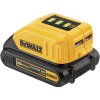flyingcheesehead
Touchdown! Greaser!
Hey folks,
I'm looking for something that I can't find: A cigarette lighter charger that has all of the following:
1) Dual 2.1 amp USB ports, like this one
2) Flush-mount or very close to it - IE, when it's in the socket, the USB ports aren't sticking out, like this one. The current one I have sticks out and in the Mooney the plug is behind the yoke, so to avoid putting stress on the USB cables I have to plug it in shortly after takeoff.
3) Works correctly with both 12/14V and 24/28V systems, like this one.
Anyone know of such a thing, or is it still unobtanium?
(EDIT: Answer below.)
I'm looking for something that I can't find: A cigarette lighter charger that has all of the following:
1) Dual 2.1 amp USB ports, like this one
2) Flush-mount or very close to it - IE, when it's in the socket, the USB ports aren't sticking out, like this one. The current one I have sticks out and in the Mooney the plug is behind the yoke, so to avoid putting stress on the USB cables I have to plug it in shortly after takeoff.
3) Works correctly with both 12/14V and 24/28V systems, like this one.
Anyone know of such a thing, or is it still unobtanium?
(EDIT: Answer below.)
Last edited:





